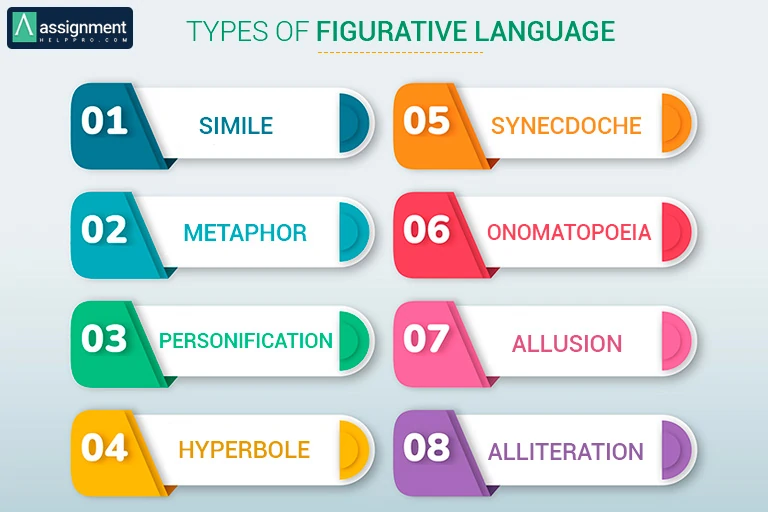Figurative language that is also referred to as “figures of speech” is one of the effective communication tools that help to communicate emotions or complex descriptions quickly and effectively. You can use figurative language to amplify your message and to persuade, connect, and engage with your audience. In order to convey your intended message clearly, you need to carefully implement figurative language in your content.
Are you confused about how to use figurative language? If yes, then this blog post is for you. Here, we will let you know about figurative language, the effective ways to use figurative language, and the different types of figurative language with examples.
What is Figurative Language?
The use of words, phrases, and sentences to convey a message in an indirect manner is known as figurative language. In general, figurative language creatively conveys a message by going beyond the literal meaning of words. Figurative language is used more often by poets and authors to create imagery and creative colors for words.
Benefits of Using Figurative Language in Writing
As mentioned earlier, figurative language is one of the useful communication tools that has numerous advantages. Therefore, without any hesitation, you can use figurative language in any form of writing, including prose and poetry to
- Describe concepts that are difficult to comprehend
- Influence the audience
- Compare concepts that are dissimilar and improve understanding of one concept
- Set up a connection
- Elicit emotion
- Visualize the description easier
Types of Figurative Language Elements
You might believe that straightforward language is simple to comprehend. Obviously, what you’re thinking is correct; however, inventive language can sometimes generate more power, easily attract the audience, and also help them comprehend more complex ideas in a more approachable manner through straightforward comparisons. As a result, figurative language can be used in writing.
In general, a variety of figurative language is available. The following are a few types of figurative language that are frequently used in contemporary writing. Explore and understand each figure of speech with examples.
- Simile
- Metaphor
- Personification
- Hyperbole
- Synecdoche
- Onomatopoeia
- Allusion
- Alliteration
Simile
A simile is a figure of speech that uses the words “like” or “as” to compare two, unlike things. It is used predominantly in our everyday communication. The ultimate aim of a Simile is to establish an interesting connection in the audience’s mind.
For example, “That Hero is as tall as a giraffe”. Here, the height of the hero is compared to the height of a Giraffe which is known for its tall height.
Other examples of similes are
- She is as brave as a lion.
- I slept like a log.
- My boss is as busy as a bee.
- My brothers fought like cats and dogs.
- Relatives are as curious as a cat.
Metaphor
The metaphor is another commonly used figure of speech that is similar to a Simile. In simple terms, a metaphor is a statement that compares two unlike things without using the words “like” or “as”. The metaphor statements usually make sense only when the audience understands the connection between the comparisons of two things. Writers use metaphors to establish a strong connection and deepen the meaning of the comparisons. The metaphors that continue for several lines are called extended metaphors.
“Love is a battlefield” is one of the popular metaphors. Here, love is compared to a battlefield. In general, the battlefield is described as a place to fight. In that context, this metaphor might mean that love was fought over.
Other examples of metaphors include
- She has a heart of stone.
- He cried a river of tears.
- Your daughter is a shining star in my classroom.
- You are my sunshine.
- My friend drowned in a sea of grief.
Personification
It refers to the attribution of human characteristics to non-living objects. Like Simile, the writers also use personification to enhance the interest of the audience on the subject of discussion. With personification, a writer can tune the audience’s imagination.
One simple example of personification is “The sun greeted me in the morning”. In general, greetings will be performed only by human beings, but here, the non-living object Sun is given human characteristics.
Listed below are other examples of personification.
- The radio suddenly stopped playing and stared at me.
- The wind howled.
- Opportunity knocked at his door.
- My heart jumped when I saw my mother after a long years.
- The alarm yelled at me in the morning.
Hyperbole
Hyperbole refers to the creation of an exaggeration to emphasize a message, an emotion, or a point. Unknowingly, we often use hyperbole in our daily life conversations. The writers use hyperbole to add depth or color to a statement. Sometimes, hyperbole also makes use of comparative words and similes.
An example of hyperbole is “He snores like a freight train”. No one would snore like the sound of a freight train, but in this sentence, an exaggeration is set on the snoring sound.
Here are a few examples of hyperbole.
- I have a million things to do today.
- He is taller than a skyscraper.
- Racing through the day was a marathon run for me.
- You could’ve knocked me over with a feather.
- You are so slender that the wind can carry you away.
Synecdoche
Synecdoche is a figurative language that uses a part of something to refer to a whole thing or a whole thing to refer to a part.
For example, a set of wheels refers to a vehicle. In a car, the wheels are only a part but not the whole thing.
Here are a few examples of Synecdoche.
- Bread refers to food or money.
- Head refers to counting people.
- Hired hands refer to workers.
- The suit refers to a businessman.
Onomatopoeia
Onomatopoeia is a language that names an action or something by imitating the sound associated with it. Writers often use onomatopoeia to add reality to their writing.
Some examples of Onomatopoeia include
- The engine roared as it climbed the hill.
- The hissing of the snake was audible.
- The water splashed all over the car.
- My stomach grumbled in hunger.
- The burning wood hissed and crackled.
Allusion
A reference to a well-known place, person, object, or historical event is called allusion. It requires the background knowledge of the audience to understand the meaning. The allusion can be either explicit or implicit.
Examples of allusion include
- She smiles like a Cheshire cat.
- Is there any Einstein in your class?
- I want to sound like Queen B.
Alliteration
Alliteration is a popular figurative language that poets predominantly use when writing poetry. It refers to the repetition of the same consonant sound at the beginning of one or more words. The writers often use alliteration to reveal a stronger description or to emphasize an emotion.
Listed below are a few examples of alliteration.
- The babble of babies brings joy to my ears.
- The pitter-patter of paws echoed down the hallway.
Final Words
We hope you have gained a better understanding of the various types of figurative language elements outlined in this blog. Remember, if you have good knowledge of figurative language, then you can very well utilize it in your writing to make it more appealing. Also, you can grasp the usage and meaning of terms when other authors use them in their work.
In case, you have any doubt regarding this concept, contact us. The language assignment experts on our platform will provide the best assistance as per your needs and will help you in improving your writing.





